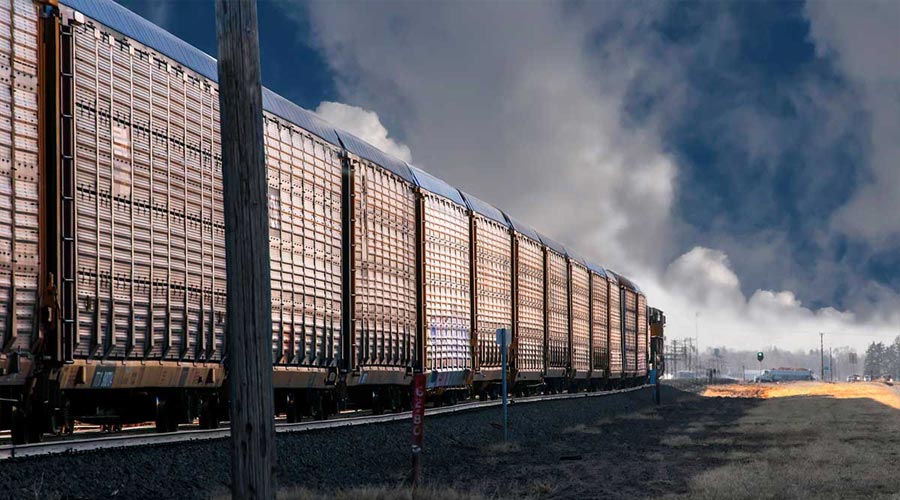Tallies, totals and other trend data in the freight transportation realm
2/11/2022
-9.0
FTR’s Shippers Conditions Index (SCI) for November improved to a -9.0 reading from October’s -12.4, FTR announced on Jan. 27. “It is likely to be 2023 before shippers experience a material gain in the performance of the supply chain,” said Todd Tranausky, FTR’s vice president of rail and intermodal.
1
American Trucking Associations’ advanced seasonally adjusted For-Hire Truck Tonnage Index increased 1% in December after rising 0.5% in November, ATA announced on Jan. 18. “In December, tonnage reached the highest level since March, but it was still 2.7% below the pre-pandemic high,” said ATA Chief Economist Bob Costello. “This is likely due to the fact ATA’s data is dominated by contract freight. Contractor truckload carriers operated fewer trucks in 2021 compared with 2020 and it is difficult to haul significantly more tonnage with fewer trucks. But overall, we have seen a nice trend up that is reflective of a still growing goods-economy.”
3
“Most economists think the Omicron variant slowed growth near the end of 2021 and into 2022 — in their January forecast, a panel of economists surveyed by the WSJ each quarter said GDP would grow 3% in Q1 2022, down from their October forecast of 4.2%.” — from the Association of American Railroads’ Feb. 4 edition of Rail Time Indicators
6
“In January, six of the 20 carload categories we track saw carload gains. Coal led the way, with carloads up 5.6% over last year. (Carloads excluding coal were down 6.0%, their biggest decline since February 2021.) Other categories with gains in January included crushed stone, sand, and gravel; chemicals; and nonmetallic minerals. January was the best month ever for U.S. carloads of chemicals.” — from the Association of American Railroads’ Feb. 4 edition of Rail Time Indicators
10
On Feb. 9, The American Transportation Research Institute released its annual list of the most congested bottlenecks for trucks in the United States. For the fourth-straight year, the intersection of I-95 and SR 4 in Fort Lee, New Jersey, was the No. 1 bottleneck. The rest of the top 10: I-71 at I-75 in Cincinnati; I-45 at I-69/US 59 in Houston; I-285 at I-85 (North) in Atlanta; I-20 at I-285 (West) in Atlanta; I-290 at I-90/I-94 in Chicago; SR 60 at SR 57 in Los Angeles; I-45 at I-30 in Dallas; I-10 at I-15 in San Bernardino, California; and I-75 at I-24 in Chattanooga, Tennessee; I-64/I-55 at I-44 in St. Louis; I-95 at I-287 in Rye, New York; and. The 2022 Top Truck Bottleneck List measures the level of truck-involved congestion at more than 300 “freight critical” locations on the national highway system.
19
“Real estate services firm CBRE Group Inc. saw a sizable development of growth in warehousing needs across the United States, noting a record amount of companies signing on for warehouses with 1 million or more square feet in the U.S., an increase of 19% of such warehouses, since 2020.” — the Feb. 10 edition of "Maersk Global Logistics Pulse”
21,400
North American Class 8 net orders “stayed steady” in January at 21,400 units, FTR officials reported on Feb. 3. The January total was down 8% month over month and 50% year over year, they added. “Backlogs have tracked in a narrow range for the last 10 months, which is odd in this cyclical industry,” said Don Ake, FTR’s vice president of commercial vehicles. “Normally, this would indicate a very stable market. In this case, it reflects a market frozen by a weak supply chain. … The big negative to the January order volume is that it indicates the supply chain has not improved yet from the end of last year. OEMs are not confident they can get parts, so they limit the number of orders they enter.”
26,500
Preliminary trailer orders for December “retreated” to 26,500 units, down 18% month over month and down 42% year over year, FTR reported on Jan. 12. As supply chain disruptions persist, OEMs “continue to manage backlogs carefully,” FTR officials said. “Orders have now averaged 26,000 units for the past four months, only a few thousand more than monthly production,” added Don Ake, FTR vice president of commercial vehicles. “That means backlogs have only gone up 6% despite there being tremendous demand for new trailers. You won’t see the order numbers consistently rise until there are ample parts to support significantly higher production. … It appears that a labor shortage at domestic suppliers is now the number one constraint.”
2 million
In conjunction with the U.S. Department of Energy’s Super Truck 3 program, the Center for Infrastructure, Transportation and the Environment at Rensselaer Polytechnic Institute (RPI) will engage in research to advance understanding of the freight transportation industry, RPI announced on Jan. 27. The institute will receive $2 million over four years as a portion of a larger $18 million grant awarded to Volvo Group North America to pioneer electrified medium- and heavy-duty trucks and freight system concepts designed to increase efficiency and lower emissions.
5 million
Leverage, which provides AI-driven supply chain visibility platforms, announced on Feb. 8 a $5 million investment of growth capital, led by Las Olas Venture Capital, Mark Cuban and Great Oaks. “I’m excited to be investing in Leverage,” Cuban said in a press release. “It’s clear there’s going to be a lot of disruption in the supply chain space, and I’m making the bet that Andrew and Nadav are the ones that are going to make it happen.” (Andrew is Leverage co-founder Andrew Stroup; Nadav is Leverage co-founder Nadav Ullman.)
87 million
J.B. Hunt Transport Inc. and Bassett Furniture Industries Inc. entered into a definitive agreement under which J.B. Hunt will acquire the assets of Zenith Freight Lines LLC, a wholly owned Bassett subsidiary, for $87 million, J.B. Hunt Transport Services Inc. announced on Jan. 31.
200 million
On Feb. 1, Chicago-based freight technology company Loadsmart announced it had secured $200 million in Series D financing from lead investor SoftBank Latin America Fund, part of the SoftBank Group, with participation from Series C investor BlackRock; CSX; and global active asset manager Janus Henderson Group. Loadsmart plans to use the funds to “rapidly expand its technology offerings, which connect shippers, carriers, brokers and warehouses for increased efficiency and transparency,” according to an email sent on Loadsmart’s behalf. In addition to CSX, the company’s investor roster includes ocean carrier Maersk, Ports America, logistics company TFI International.
340 million
“Based on current business trends and production schedules for fiscal 2022, Greenbrier expects: increased [rail car] deliveries of 17,500–19,500 units including approximately 1,500 units in Greenbrier-Maxion (Brazil) … [and] capital expenditures of $275 million in Leasing & Management Services, $55 million in Manufacturing and $10 million in Maintenance Services.” [total: $340 million] — Greenbrier Cos. Inc. Chairman and CEO William Furman, announcing the equipment supplier’s Q1 financials on Jan. 7
420 million
project44, a supply chain visibility platform for shippers and logistics providers, received an investment totaling $420 million via a syndicate led by Thoma Bravo, TPG and Goldman Sachs Asset Management, the company announced Jan. 11. When combined with its $202 million equity raise in May 2021, the $420 million “set a funding record for Logistics Tech enterprise SaaS companies” in a transaction that values project44 at “$2.2 billion pre-money,” project44 officials said.
